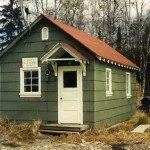Our History
Churches grow, move with new congregations, Soldotna Methodist Church History
By Clark Fair of the Redoubt Reporter Newspaper
Both of the first two Methodist churches in Soldotna were hauled from the Kasilof area and brought whole across the Kenai River bridge. During these moves, adjustments had to be made because the smaller church sat a little too high, while the larger church sat a little too low.
The earliest Methodist church on the western Kenai Peninsula was the first church structure in Soldotna. It was originally known as the Kasilof Methodist Church, and it predated the now more-established Methodist church in Kenai. According to information in the photo archive at Kenai Peninsula College, the one-story, one-room building — complete with greenish exterior walls, white-painted door and window trim, and a red roof — was moved out of Kasilof once a greater Methodist population grew in Soldotna.
Probably in late 1951, church members agreed to move onto property donated by homesteader Maxine Lee at Mile 0.5 of the Kenai Spur Highway, and they hired Homer Freight Lines to jack up and haul the structure. At the bridge, they realized that the top of the building would strike the overhead steel supports, so they had to deflate the tires on the trailer in order to create the proper clearance.
A photograph taken in April 1952 shows a small group of Methodist children posing with itinerant Moose Pass minister, Gene Elliott, in front of the new church, which, with its small oil stove, was difficult to heat in the winter. Area Methodists used this church into the mid-1950s when a new, much larger, church was built in Kenai.
On Jan. 15, 1955, Pastor Quincy Murphree mailed two postcards to every box holder in Kenai. The first read, “Dear People: If you are interested in a Methodist Church in Kenai, fill in the attached postcard and return it to me at once. Do not fail to register your interest in one of the provided places.” The second card read, “I am interested in a Methodist Church in Kenai and will (A) become a member ____, (B) I do not care to become a member, but will attend regularly ____, (C) most of the time ____, (D) occasionally ____. My name is ____________________.”
Based on the results of this survey, the Kenai Methodist Church was born, with the first service being held on Feb. 13, 1955, in the Civic Center with 37 people in attendance. Although someone had tampered with the furnace, leaving the indoor temperature at 33 degrees, the faithful were not deterred. In fact, on Easter Sunday a few weeks later, 77 people showed up to worship.
The following week, 19 individuals joined the church on Charter Membership Day. Two years later, the large new church, constructed with nearly 2,000 hours of volunteer labor and located next to the Kenai School, was consecrated. The tiny Soldotna church was abandoned and transformed into an office building for the Coastal Drilling Company.
By 1965, however, the Soldotna Methodists, tired of the weekly commute to Kenai, wanted their building back. Coastal Drilling complied. The old church — now renamed Soldat Kriste (“Soldier of Christ”) — was picked up and hauled again, this time to a wooded lot just north of town, where it served the congregation until 1968, when a new, two-story Methodist parsonage was built nearby, and services were held in the much more spacious parsonage basement.
Meanwhile, moves were afoot to create even more room and a real church. Property on Binkley Street was purchased, and a merger between the congregations of Soldotna and Kasilof was formed.
Photo courtesy of Soldotna United Methodist Church archives. The Tustumena Church of Christ the Victor is hauled from Kasilof across the Kenai River bridge to its new location in Soldotna, and its new name, Soldotna Methodist Church, in 1968.
Built next to the Tustumena School in the mid-1960s under the direction of Pastor John Shaffer, the Tustumena Church of Christ the Victor, with its striking diamond shape and sky-piercing sanctuary, was jacked up on Aug. 2, 1968, placed on a flatbed freight hauler preceded by a truck bearing a sign, “EX-WIDE LOAD,” and aimed toward Soldotna.
The church was so wide that the movers decided to transport the building only between the hours of 4 and 6:30 a.m., when it was determined that traffic would be the lightest. The 15-mile journey took two days and was slowed at the river because the entire structure had to be jacked up so that its bottom could pass over the top railings of the new bridge that had replaced the old steel-girder assembly.
The first worship service at the new location, now called Soldotna United Methodist Church, was held Aug. 18, 1968.
In the late 1950s and throughout the 1960s, several other area churches also got their starts, including the Kasilof Community Church (organized in parishioners’ homes starting in about 1947 and in an official church building by 1958), in Soldotna.
The Soldotna Methodist Church, despite its start back in the early 1950s, was not even close to being the first Methodist church on the peninsula. That honor goes to the Seward Methodist Episcopal Church, which was constructed in 1907 by its first pastor, Louis H. Pedersen, who had arrived in town two years earlier.
Seward had a number of churches that began nearly or more than a century ago. Among them are a Christian Science church (now defunct), which began in the community library in about 1915; the Sacred Heart Catholic Church, which was begun by Father Phillip Turnell after his arrival in June 1905; St. Peter’s Episcopal Church, in which the first services were held by the Rev. F.C. Taylor on June 12, 1904; and the Seward Lutheran Church, the members of which began meeting occasionally starting in 1917.

